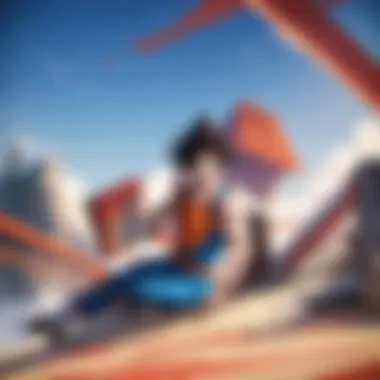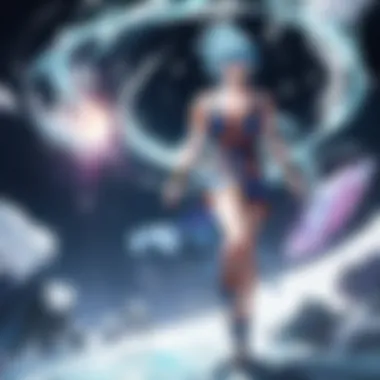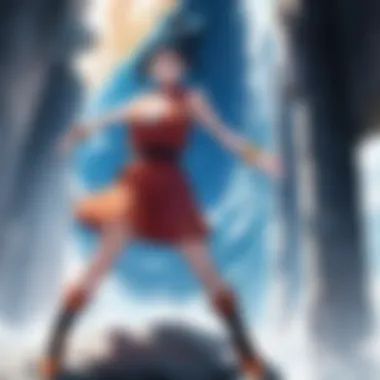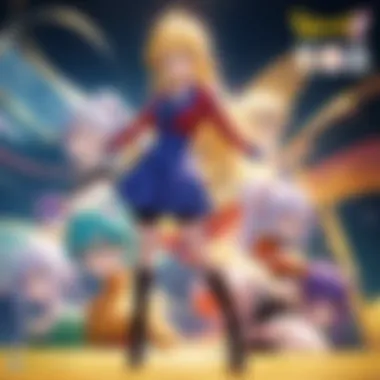Exploring the Full Season of Dragon Ball Super


Intro
The univers of Dragon Ball Super represents a complex tapestry woven with themes of friendship, rivalry, and the eternal quest for strength. This series is a continuation of the beloved Dragon Ball franchise, pushing the boundaries of character development and exposition. By analyzing the key narrative structures, the character arcs, and thematic elements, one can appreciate the depth this installment offers. A thorough exploration not only enriches the understanding of Dragon Ball Super but also positions it within the wider context of the anime and manga industries.
Character Profiles
Overview of Main Characters
The main characters of Dragon Ball Super are a reflection of endurance and growth. Goku, the series protagonist, remains at the forefront. His unfased aspire to become stronger is showcased through numerous battles and transformations. Vegeta, Goku’s counterpart, showcases a contrasting motivation, with his character evolving from just pure rivalry into a deeper understanding of family and honor.
Moreover, Gohan, who once held immense promise, faces a different narrative angle, emphasizing personal struggle alongside his desire to balance duty and legacy. These main characters embody the ever-present themes of strength, both physical and emotional.
Supporting Characters
The supporting cast adds considerable wealth to the narrative. Characters like Beerus, the God of Destruction, and Whis, his angelic attendant, introduce complexities and cosmic stakes that heighten the series’ tension. Additionally, characters like Frieza, who often oscillate between ally and enemy, underscore the unpredictability of alliances.
Bulma, Krillin, and Piccolo also play crucial roles, enriching the story with their unique perspectives. Each supporting character’s growth has significant implications on the main narrative, proving that their contributions are equally vital. Their interactions add layers that enhance the overall storyline.
Theme Exploration
Central Themes
Dragon Ball Super emphasizes themes of ambition and perseverance. The relentless pursuit of improvement is a driving force throughout the arcs. The series illustrates that strength comes not just from physical prowess, but also from emotional resilience and moral fortitude. Friendship serves as another central theme; the bonds formed through trials are as important as the battles fought. Character relationships evolve, showing the importance of trust and support.
Cultural References
Cultural nuances play a significant role in shaping character motivations and narrative direction. The series often references Japanese folklore and traditional values such as honor and sacrifice. Elements of collaboration among characters reflect societal norms of teamwork, something pivotal in the epic battles they face.
“Examining these cultural influences enhances the viewer's understanding of character choices and thematic depth.”
Popular Series and Recommendations
Top Anime Series of the Year
For those captivated by Dragon Ball Super, several anime have resonated well with audiences in recent years:
- Jujutsu Kaisen
- Attack on Titan
- My Hero Academia
These series share thematic depth and intense character development, making them appealing to fans of the genre. They represent the going trend of incorporating deeper narratives alongside action.
Hidden Gems in Manga
In the manga realm, enthusiasts might consider exploring:
- Tokyo Revengers
- Chainsaw Man
- Kaiju No. 8
Each of these titles offers a unique narrative structure and character depth, similar to the merits found in Dragon Ball Super.
This exploration of Dragon Ball Super reveals the intricate layers that define its contribution to the anime and manga industries. Each section enhances the narrative understanding, becoming imperative for fans and scholars alike.


Foreword to Dragon Ball Super
The introduction of Dragon Ball Super marks a significant evolution in the widely acclaimed Dragon Ball franchise. This section emphasizes its importance by highlighting how it continues the legacy of its predecessors while diving deeper into character arcs and thematic complexities. Many fans see the introduction as more than just another series; it is a fresh take that attempts to capture how storytelling in anime can adapt and respond to audiences over time.
Understanding the transition from the original shows, like Dragon Ball Z, to Dragon Ball Super offers valuable perspectives on anime development. In this section, we will dissect key components that make Dragon Ball Super a unique entry within the franchise. This cohesive narrative showcases the expansion of the overarching plot, the introduction of new characters and villains, and the broader implication of its themes in contemporary society.
Overview of the Dragon Ball Franchise
The Dragon Ball franchise has had a remarkable journey. It began as a manga series created by Akira Toriyama in 1984. It developed a robust television series and multiple spin-offs, including Dragon Ball Z and Dragon Ball GT. Over the years, its global popularity has spawned numerous movies, games, and merchandise.
The franchise is known for its exhilarating battles, moral lessons, and character development. Among its many themes, the essence of friendship, courage, and the continual pursuit of strength resonate strongly with viewers. Fans appreciate how the series evolves, introducing new elements while maintaining core values that fans have come to adore. The release of Dragon Ball Super reinvigorated interest in the series, attracting both old and new audiences.
The Transition from Dragon Ball Z to Super
The transition from Dragon Ball Z to Dragon Ball Super is a noteworthy aspect of the series. While Dragon Ball Z focused primarily on the battles against formidable foes, Dragon Ball Super expands on the narrative by diving into different universes, introducing concepts like the Multiverse and Gods of Destruction. This shift offers a broader canvas where characters can explore deeper motives and relationships.
Fans witnessed the evolution of familiar characters like Goku and Vegeta. Their growth is not limited to power levels; it encompasses emotional and psychological aspects as well. As they face new challenges, they must also confront their past and the legacy they wish to leave behind.
"Dragon Ball Super does not just continue the story; it gives us a chance to re-examine what we have come to love about this franchise."
Overall, the transition signifies a mature approach to storytelling. The narratives in Dragon Ball Super reflect contemporary themes, engaging audiences on multiple levels. This section lays critical groundwork for understanding the ensuing story arcs, character developments, and themes that define Dragon Ball Super.
Key Story Arcs in Dragon Ball Super
The significance of the story arcs in Dragon Ball Super cannot be overstated. Each arc introduces unique challenges that contribute to character development and overarching themes present in the series. These arcs create a narrative structure that is essential for exploring concepts like strength, resilience, and the complexities of friendship. With each new challenge, viewers witness the evolution of their beloved characters, which keeps the audience engaged and invested.
The God of Destruction Saga
The God of Destruction Saga marks the introduction of new cosmic entities and sets the tone for the power scale of Dragon Ball Super. Here, the character Beerus, the God of Destruction, awakens from a long slumber. His quest to find a worthy opponent leads him to Goku and Vegeta. The significance of this arc lies in its exploration of divine power and responsibility.
The saga lays the groundwork for the battles that follow and establishes Goku's aspiration to become stronger. It is also pivotal in highlighting the theme of competition, making Goku driven to not only uphold Earth’s safety but also to challenge himself against the best.
The Universe Tournament Arc
In the Universe 6 Tournament Arc, the focus shifts to a competition between Universe 6 and Universe 7. This arc is crucial for establishing the concept of multiple universes within the Dragon Ball cosmos. The introduction of characters like Hit and Cabba adds layers to the story, fostering connections between various universes.
This tournament serves as a vehicle for character development. Goku's fight with Hit emphasizes his desire to grow, while Vegeta's engagement with Cabba showcases a rare moment of mentorship. It encapsulates themes of rivalry and respect. In summary, this arc not only entertains but also expands the narrative possibilities of the Dragon Ball universe.
Future Trunks Saga
The Future Trunks Saga takes a darker turn, delving into a post-apocalyptic scenario. Trunks arrives from a devastated future to warn the Z fighters about the threat posed by Goku Black. This arc is significant due to its emotional weight; it explores loss, despair, and the fight for survival. Trunks, already seen as a formidable fighter, is forced to confront his own failures, which adds depth to his character.
The revelation of Goku Black's true identity and the conflict between Trunks and Zamasu elevates the stakes. Additionally, the return of characters like Mai adds layers of emotional connection. This arc serves to remind the audience that power carries responsibility, making it a thought-provoking segment of the series.
The Universe Survival Arc
In the Universe Survival Arc, we witness the Tournament of Power, where multiple universes battle for survival. This arc embodies the culmination of alliances and rivalries established throughout the series. The stakes are higher than ever, as the losing universes are erased from existence. The urgency of this arc forces characters to rethink their motivations and unite for a common purpose.
This arc highlights the unity and diversity present in the Dragon Ball universe. We see characters from various backgrounds come together. Notably, the prominence of Jiren as a formidable opponent emphasizes the concept of strength in solitude versus the strength of camaraderie. Overall, this arc represents a significant thematic pivot in the series, merging individual aspirations with collective survival.
Each arc in Dragon Ball Super offers a unique lens through which we can explore deeper meanings behind strength, friendship, and existential challenges.


In summary, the story arcs in Dragon Ball Super are not simply a backdrop for fights; they are integral to the series’ ability to explore complex themes while evolving characters. They highlight the transformative potential of challenges and showcase how individuals rise to meet them.
Character Development in Dragon Ball Super
Character development in Dragon Ball Super is essential for understanding not just the individual characters but also the overarching narrative of the series. This season marks significant growth for main characters like Goku and Vegeta, along with various side characters. Their journeys are marked by struggles, victories, and a continual evolution that reflects the nature of growth in life.
In detail, Goku's transformations are an exploration of his desires and determination. He aims to surpass limits, which resonates with the audience's aspirations. Vegeta's redemption arc shows a deepening complexity, making his character multilayered rather than just a rival. Furthermore, the treatment of side characters showcases the themes of friendship and strength, enriching the story.
A thorough examination of these developments offers insights into the series' impact on viewers and its contribution to the genre itself.
Goku's Transformation and Growth
Goku is a pivotal character in Dragon Ball Super, and his transformation reflects both physical strength and mental resilience. His development throughout the series emphasizes his relentless pursuit of strength and his challenges. Each transformation, whether it is Super Saiyan God or Ultra Instinct, signifies not just improved fighting abilities but an internal journey as well.
This pursuit often brings out Goku's character traits, such as his insatiable drive to confront formidable opponents. This compels him to test boundaries and adapt, which ultimately allows for significant growth. Each battle serves as a lesson, pushing him to transcend his limits.
"Goku's growth is an ongoing quest that mirrors human struggles for self-improvement."
His relationships with allies and rivals also aid his transformation. Goku reveals his nature as a protector, willing to sacrifice for his friends and family. This aspect of his character makes his evolution deeply relatable to the audience.
Vegeta's Journey Towards Redemption
Vegeta presents an intricate journey characterized by the conflict between pride and humility. Initially, he is portrayed as an antagonist with a heavy reliance on his elite status as a Saiyan. However, throughout Dragon Ball Super, Vegeta undergoes substantial character development.
His rivalry with Goku evolves into something more than mere competition. It becomes a source of motivation for him to become better, not only as a warrior but also as a person. Vegeta's struggles with his past errors, especially in how he treats others, demonstrate a shift toward redemption. He learns to embrace teamwork, showing vulnerability rather than just brute strength.
Vegeta's progression also highlights themes of family as he takes on a protective role towards his children. This transformation adds depth to his character, moving him closer to becoming a hero, challenging the archetype of purely evil characters in anime.
Exploration of Side Characters
The side characters in Dragon Ball Super are not mere embellishments; they offer distinct perspectives that enrich the main narrative. Characters such as Piccolo, Frieza, and even characters from the Universe 6 Tournament play crucial roles in supporting the main cast while also evolving themselves.
For instance, Piccolo’s mentorship of Gohan reflects themes of growth and legacy. Their dynamic showcases how guidance can lead to personal growth for both mentor and mentee. Similarly, Frieza’s reluctant alliances during key battles expose layers of his character, complicating our initial impressions of him.
Moreover, new characters introduced in the Universe Survival Arc add variety and depth. They serve to challenge established characters, leading to new storylines that emphasize resilience and cooperation in facing common threats.
The evolution of these side characters challenges the traditional narrative focus on a single protagonist, suggesting an ensemble approach that encourages broader character arcs and complex interactions. This aspect greatly enhances the richness of the overall story, showing that everyone can grow and evolve, not just those in the limelight.
Thematic Elements in Dragon Ball Super
Thematic elements play a significant role in the narrative framework of Dragon Ball Super. This anime and manga series enrich the experience for its audience by exploring ideas that resonate with viewers on various levels. The themes of friendship, rivalry, strength, and cultural reflections contribute to a deeper understanding of character motivations and the moral dilemmas they face. Each theme not only shapes the characters but also provides context for their actions, making the story more relatable and engaging for fans.
Friendship and Rivalry
Friendship and rivalry are two intertwined themes that drive character dynamics throughout Dragon Ball Super. The relationship between Goku and Vegeta exemplifies this duality perfectly. Their rivalry is built on mutual respect and a shared goal of becoming stronger. Despite their competitive nature, they support each other in times of need. This complexity calls into question the nature of rivalry itself. Is it purely an adversarial relationship or can it become a catalyst for growth?
Moreover, friendships are not limited to the main characters. The bonds formed among the diverse cast, including Gohan, Piccolo, and even newcomers like Jiren, highlight the importance of unity in the face of overwhelming challenges. The show encourages viewers to value these connections, showing how friendships can develop into powerful alliances that overcome adversity.
The Concept of Strength
The concept of strength in Dragon Ball Super goes beyond physical prowess. It nuances the definition of what it means to be strong. Characters wrestle with not only their physical limitations but also their moral and emotional boundaries. Goku embodies the aspiration to surpass limits; he constantly seeks strength not just for himself but for his loved ones and the universe.


Vegeta, conversely, represents a different philosophical approach towards strength. His growth encapsulates a shift from pure aggression to understanding and accepting help from others. This thematic divergence presents strength as a multifaceted attribute, combining inner resilience with physical capability.
Ultimately, the series pushes the idea that true strength is measured by growth, sacrifice, and the willingness to protect those one cares about.
Cultural Reflections in the Story
Dragon Ball Super serves as a mirror reflecting various cultural elements from both Japanese society and broader global contexts. It navigates themes such as the importance of family, the struggle against oppressive forces, and the celebration of diversity. The diverse arenas and characters showcased throughout the series celebrate the richness of various cultures, accentuating the universal appeal of the narrative.
The story also reflects societal values such as teamwork and perseverance in overcoming obstacles. For instance, the Universe Survival Arc introduces a multi-universal competition that emphasizes collaboration among different fighters and races. This interplay not only enriches the plot but also suggests an underlying message about unity in diversity.
Cultural Impact and Legacy
The cultural impact and legacy of "Dragon Ball Super" is significant within the anime landscape. This section aims to provide insight into how the show has resonated with fans and critics alike, solidifying its place in not just the Dragon Ball franchise but the wider world of media. The series has transcended mere entertainment; it functions as a cultural phenomenon that shapes and reflects aspects of societal values, relationships, and conflict. Through a blend of compelling narratives and distinctive character arcs, the series encourages discussions that extend beyond the screen.
Reception among Fans and Critics
The reception of "Dragon Ball Super" has been varied, but it generally leans positive. Fans of the original series, as well as newcomers, have embraced the expansion of the Dragon Ball universe. Critics appreciate the blend of nostalgia and innovation brought forth by this new installment. Many point to the series' ability to incorporate modern animation techniques while remaining loyal to its roots.
Feedback from fan communities on platforms such as Reddit showcases a vibrant discourse. For instance, many fans have highlighted:
- Character Development: Viewers often regard Goku and Vegeta's evolution favorably, noting their growth in strength and personality.
- Story Arcs: The Tournament arcs have drawn significant praise for their structure and pacing.
- Visual Quality: Many fans appreciate the improved animation style, particularly during fight scenes.
However, it's worth mentioning that not all feedback is positive. Some critics believe the pacing can be uneven, especially in certain arcs. Despite these drawbacks, the positive reception underscores the show's fortitude in maintaining cultural relevance.
Influence on Other Anime and Media
"Dragon Ball Super" has set a standard in anime, influencing countless series that followed. Its themes of friendship, rivalry, and personal growth resonate widely, making them accessible in various contexts. This influence can be seen in newer anime that borrow from its narrative style, character development, and action sequences.
Moreover, its global impact extends beyond anime. Video games, merchandise, and fan art have proliferated, influenced by the characters and storylines from this series. For example:
- Video games: Titles like "Dragon Ball FighterZ" have integrated elements seen in "Dragon Ball Super," enhancing player engagement through familiar story arcs and characters.
- Merchandise: Action figures and collectibles from the series continue to dominate sales, indicating the enduring popularity of the characters.
- Crossover Events: Other anime series have featured crossover events or nods to Dragon Ball, illustrating its influential reach.
As the series continues to be relevant, it serves as a high benchmark for quality, fans expect a similar level of depth and character building in future works.
"Dragon Ball Super has become not just a continuation of a beloved franchise, but a cultural touchstone that influences various forms of media today."
In sum, the cultural impact and legacy of "Dragon Ball Super" are substantial. The series not only satisfies avid fans but also continues to cultivate new audiences, ensuring its standing within the anime genre.
The End
The conclusion serves as a pivotal component of understanding the full depth of Dragon Ball Super. It synthesizes the significant themes, character arcs, and narrative strands explored throughout the article. This section not only summarizes core insights but also emphasizes the lasting impact the series has had on both fans and the anime landscape.
Final Thoughts on Dragon Ball Super
Dragon Ball Super revitalizes the beloved franchise by introducing fresh narratives while respecting the established lore. It expertly balances nostalgia with innovation, allowing both new and returning fans to engage deeply with the story. The nuanced character development, particularly of Goku and Vegeta, showcases their evolution not as mere fighters but as complex individuals. Each saga adds layers to their personas, reflecting growth and maturity that resonate with viewers.
The series stands out by addressing more than just battles. It investigates themes of friendship, rivalry, and strength, which are fundamental to its essence. The interactions among characters lend profound meaning to their journeys. Ultimately, Dragon Ball Super encourages viewers to reflect on their values and relationships, making it not only entertaining but also thought-provoking.
Future Prospects of the Franchise
Looking ahead, the future of the Dragon Ball franchise appears promising. With a robust fan base, there remains ample opportunity for expansion. New arcs, characters, and possible adaptations can introduce various narratives that stay true to the series' roots while exploring uncharted territories.
Upcoming projects, such as new movies or series continuation, can enhance the existing lore. Developments in digital platforms also open avenues for exploring Dragon Ball Super in novel formats, potentially attracting younger audiences.
"The legacy of Dragon Ball continues, and its influence on anime and pop culture remains significant."
This longevity speaks volumes about its impact. The community engaged through discussions on platforms like Reddit further solidifies its place in anime history. The melding of old and new storytelling techniques presents exciting prospects for both creators and fans alike, ensuring that Dragon Ball Super remains a vital part of the cultural fabric.







